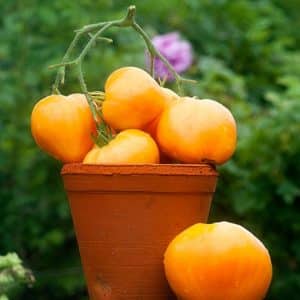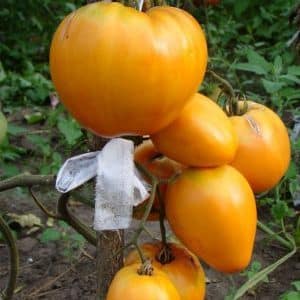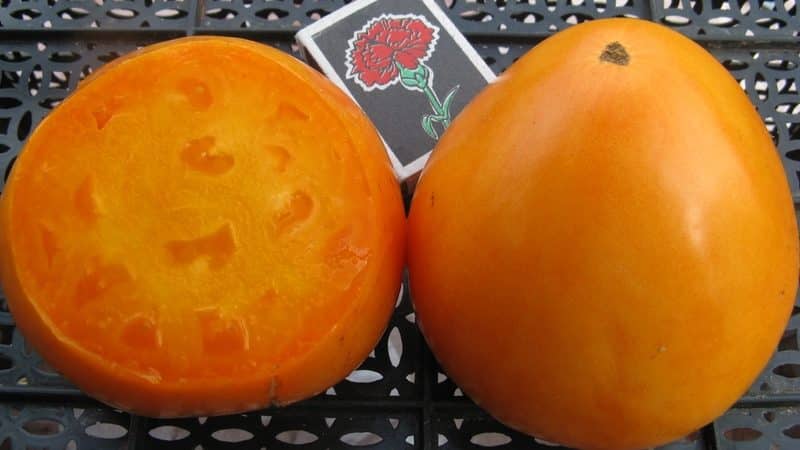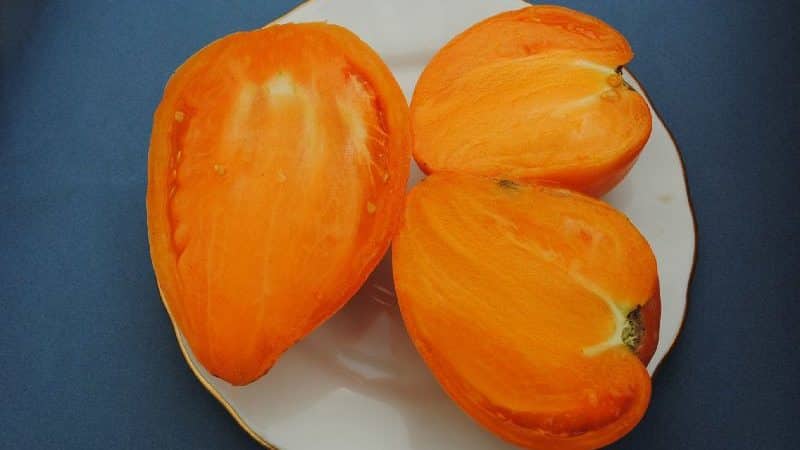Tasty and time-tested tomato “Heart of Ashgabat”: review of the variety and the basics of its cultivation
Breeders create dozens of new tomato varieties every year. They differ in care requirements, fruit color, bush shape, and ripening speed. Despite all the variety, many gardeners prefer old, proven tomatoes.
One of the most popular tomatoes is the Heart of Ashgabat. It first appeared in gardening markets almost half a century ago. During this time, not many varieties were released that could surpass it in ease of care, taste and size of the fruit. Let's get to know him in more detail.
General description of the variety
The heart of Ashgabat is the varietal tomato. It was bred in the USSR by Turkmen breeders. The name and surname of the originator are unknown, so the tomato is called the development of folk selection.
In 1972, the tomato was included in the Russian state register. Since then, its popularity has not diminished.
Advice. The largest tomatoes are allowed to fully ripen on the bushes. Their seeds are collected, cleared of pulp and stored in fabric bags. It is from such planting material that the strongest and most productive plants are obtained.
Distinctive features
The heart of Ashgabat is distinguished by large beautiful fruits. They are bright orange in color, with small pinkish spots. Their shape resembles a heart, which is why the variety got its name.
 Tomato berries are fleshy and juicy. They have a rich sweet taste with unexpressed sourness. Tomato aroma.
Tomato berries are fleshy and juicy. They have a rich sweet taste with unexpressed sourness. Tomato aroma.
The fruits have a high content of beta-carotene and lycopene. Thanks to this, they help remove harmful substances from the body, improve vision and strengthen the immune system. Moreover, such tomatoes do not cause allergies and have a low concentration of purines. They are useful for children, allergy sufferers and people suffering from vitamin deficiency.
Tomato has a high yield.
Another positive quality of the Heart of Ashgabat is the high immunity to fungal diseases of tomato crops. The variety is not afraid even of late blight.
Like most other tomatoes, it is demanding of light and temperature. The variety is not cold-resistant. Also among the disadvantages of the Heart of Ashgabat, gardeners include the fact that it will not produce a good harvest without regular and proper fertilizing.
Main characteristics
The popularity of the variety is due to its impressive characteristics and tasty fruits. In terms of productivity and disease resistance, it is not inferior to younger breeding achievements.
A detailed description of the Heart of Ashgabat is given in the table.
| Parameter | Indicators |
| Bush type | Semi-determinant, standard. The height of the main stem varies between 100-140 cm. The leaves are medium-sized, simple, light green in color. The bushes are powerful, with a small number of leaves. The inflorescences are simple, the first is formed at the level of 6-8 leaves, the next after 1-2 leaves. The fruits are formed in clusters of 2-4 pieces. |
| Growing method | Cultivated in open and protected ground. |
| Productivity | High. From 4-7 kg of fruits are collected from one bush. From 1 sq. m get from 20 to 30 kg of harvest. |
| Fruit | Large size. On average, the weight of one fruit reaches 250-500 g. Individual specimens weigh 600-800 g. The color of the fruit is bright orange inside and out.There are pinkish spots. There is no green area at the base. The shape is heart-shaped, sometimes with a point at the tip, sometimes not. There is pronounced ribbing at the base, thanks to which the berries resemble a heart. There is a lot of pulp and it is juicy. The dry matter content does not exceed 6%. The taste is sweet without sourness. The number of seed chambers in each fruit does not exceed 7 pieces. |
| Transportability | High. The fruits are not damaged during transportation and are stored for more than a month. |
| Ripening time | Mid-season variety. The berries ripen 110-115 days after sowing the seeds. |
| Disease resistance | It is resistant to fungal diseases of tomatoes. |
Growing seedlings

Mid-season tomatoes are grown in seedlings. This is the only way they have time to ripen before the onset of frost in our country.
The key to productive tomatoes is strong and healthy seedlings. To obtain such plants, it is important to take a responsible approach to each stage of their cultivation.
Seed treatment
One of the most important stages of growing seedlings is the preparation of planting material. The resistance of the variety to diseases and negative environmental factors depends on how correctly this procedure is performed:
- First of all, choose planting material that will germinate. To do this, the seeds are soaked in warm salted water (1 teaspoon of salt per 1 cup of water). For planting, only those specimens that have sunk to the bottom are used.
- Planting material is disinfected, since infections persist on the seeds. It is soaked for 20 minutes in a light pink solution of potassium permanganate or hydrogen peroxide. They also use folk remedies that not only disinfect seeds, but also stimulate their germination.As such, use aloe juice, diluted in half with water, or a soda solution (1 tsp per 1 cup of water). The planting material is kept in such preparations for 12 hours.
- The last stage of processing tomato seeds is to stimulate their growth. This procedure not only speeds up their germination, but also increases cold resistance. They use purchased products (“Epin”, “Sodium Humate”) or homemade preparations (honey water).
Note! Some gardeners prefer to germinate seeds in advance. In this case, the planting material is placed on napkins moistened with a growth stimulator, which cover the bottom of a deep container. They are covered with several more layers of damp gauze. Before germination, they are kept in a warm place, periodically wetting the material with warm water.
Selection of containers and soil
When growing seedlings in a heated greenhouse, use the same soil in which adult tomatoes will grow. It is disinfected with hot copper sulfate.
When growing at home, prepare a special soil mixture. They take soil from the area where adult tomatoes will be grown. It is mixed in equal proportions with humus or peat (sometimes two options are taken at once). Add half of the sand, sawdust or coconut substrate to the soil. A bucket of this composition is mixed with 1 tbsp. ash and 1 matchbox of superphosphate.
Suitable for growing seedlings and purchased soil. Choose a universal soil mixture or special soil for tomatoes and peppers.
Both purchased and homemade soil are disinfected. It is poured with a dark pink solution of potassium permanganate, hot copper sulfate or calcined in the oven.
Inexpensive tomato varieties, which include the Heart of Ashgabat, are first sown in a common box.They use both special containers for seedlings and improvised materials (boxes of semi-finished products, cut-off six-liter bottles, etc.).
When the seedlings grow, they are planted in separate containers with a volume of 300-500 ml. Plastic cups, peat pots, cut 1-2 liter bottles are suitable.
Important. Containers are also disinfected. It is enough to soak them for half an hour in a dark pink solution of potassium permanganate.
Sowing planting material
Heart of Ashgabat seeds are sown 55-60 days before tomatoes are planted in the ground. As a rule, this happens in March.
The seedling boxes are filled with soil, which is watered with warm water. Grooves 1 cm deep are made in the soil at a distance of 3 cm from each other. Seeds are placed in the recesses at intervals of 2 cm.
The seeds are covered with soil. The containers are covered with film and placed in a warm place. Every day the film is opened slightly for 15-20 minutes so that the water does not stagnate.
Seedling care
Growing seedlings is a simple but responsible process. The main thing is to follow the basic rules:
- When the seeds germinate, remove the film. Plants are placed on the windowsill. If the seedlings do not have enough natural light, use fluorescent lamps.
- Water the tomatoes as the soil dries. It is important to use water at room temperature and make sure that it does not come into contact with the greenery of the plants.
- Make sure that the seedlings are not exposed to a draft. Otherwise, fragile plants will die.
- When two true leaves form on the plants, they are planted in individual containers, the bottom of which must be filled with drainage. For 10 days after transplantation, tomatoes are not watered or fed.
- 14 days after picking the tomatoes, apply the first fertilizing. The next two times the soil is fertilized with an interval of two weeks. Use complex fertilizers that include phosphorus.
- Before planting tomatoes in a permanent place, they are hardened off. Before this, two weeks before picking, the seedlings begin to be taken out into the fresh air, gradually increasing the time they stay there.
Agricultural technology of the Heart of Ashgabat
Tomatoes are transplanted into open ground when the soil warms up at a depth of 15 cm. In greenhouses, planting is possible two weeks earlier.
The time for planting seedlings in open ground depends on the region:
- southern - late April or early May;
- central - mid or late May;
- northern - early June.
Before picking, the seedlings must be fed and watered. This will help her quickly settle into a new place.
Planting tomatoes in the ground
The tomato beds are being dug up. They are cleared of weeds and enriched with fertilizers. For 1 sq. m add 6 kg of rotted manure. If the acidity of the soil is increased, additionally add dry lime or ash.
Advice. Gardeners recommend chopping the tops of last year's tomatoes, pouring potassium permanganate and dipping them into future tomato beds. In spring, the tops will turn into nutritious fertilizer.
In the spring, the beds are dug up or leveled with a rake and cleared of weeds. They are poured with hot copper sulfate.
The holes are dug in rows in a checkerboard pattern. For 1 sq. m place no more than five plants.
Ash or dry granular fertilizers are poured into the holes. Some gardeners throw one small fresh fish there.
Immediately before planting, tomatoes are removed from the pots. They are carefully moved into the holes, deepening to the lower leaves. The depressions are filled with soil, which is compacted.
The plants are watered, spending a liter of warm water on each of them.The next watering is done after two weeks.
Care
The heart of Ashgabat must be tied up. Not only the main stem, but also clusters with heavy fruits are attached to the support. They use synthetic thread that is not subject to rotting.
Form a tomato into 2-3 stems. The fewer stems remain, the larger the fruits will be, but the fewer of them there will be.

During the formation process, withered leaves and greenery below the first flower cluster are removed. No more than three leaves are torn off in one procedure.
Water tomatoes 2-3 times a week. At least two liters of water are used per plant. The soil is moistened early in the morning or at sunset so that water does not fall on the ground part of the plants. On planting days, tomatoes are not watered.
After each glaze The soil is loosened and weeds are removed in the process.
The heart of Ashgabat loves feeding. They are applied at least four times per season. Alternate complex mineral and organic (silage, humus, chicken manure).
The lazy way to grow tomatoes
There is an interesting new method that gardeners call "lazy". It consists of a special method of planting tomatoes in a permanent place, which allows you to spend a minimum of time on care during the entire growing season.
For tomatoes, dig holes 50 cm wide and 30 cm deep. The distance between the holes should be 1.2 m. A high wooden support is installed in the center of the hole.
The bottom of each hole is covered with layers of a bucket of rotted manure, humus and sand. The rest of the volume is filled with garden soil. 85 g of nitrophoska and 0.5 kg of ash are added to each cavity. All components are thoroughly mixed.
5 tomatoes, 60 days old, are planted in each hole. Greenery is removed from the bottom of the bush.They are tied to one support located in the center of the recess.
Each hole is watered with 1 liter of water. Then they mulch hay, straw, fallen leaves or burlap.
Water tomatoes 1-2 times a week. There is no need to loosen the beds. There will definitely be worms in the nutrient substrate that will do this for you.
When growing using the lazy method, you will only need one for the entire summer. feeding. Chicken manure diluted 1/10 with water is used as fertilizer. Tomatoes are sprayed with boric acid 3 times a season.
This is all the care your tomatoes will need. Gardeners who have tried it say that they get 20-40 kg of fruit from one hole per season.
Diseases and pests
Heart of Ashgabat is a variety that is resistant to fungal diseases of tomatoes. It does not have high immunity to viral diseases.
To reduce the risk of infection, it is important to follow the basic rules of prevention:
- Maintain crop rotation. Tomatoes are not planted in beds after nightshade crops.
- Disinfect soil, containers, seeds and garden tools.
- The right neighborhood. Potatoes should not be planted next to tomatoes.
- Compliance with the rules of watering and pinching. The soil should not be waterlogged or dry. Do not allow water to enter the above-ground part of the plants.
- Protection from insects. Pests - carriers of viruses and bacteria. To scare them away from tomato bushes, the plants are sprayed with a decoction of wormwood or “Barrier”. If small pests have already affected the tomatoes, then use a soap solution (1 piece of soap rubbed into a bucket of water).
Features of cultivating the variety in open and protected ground

Before planting tomatoes in a greenhouse, be sure to treat the walls with copper sulfate. The soil in the beds is being replaced.New soil is also disinfected.
Ventilation is another important step. This procedure helps maintain optimal humidity in the room, reducing the likelihood of plant infection.
In a greenhouse, plants are helped to pollinate. The first option is to periodically shake the bushes during flowering. The second way is to install a fan in the room.
In a greenhouse, tomatoes are watered once a week, and in open ground - 2-3 times.
At night, tomatoes planted in open ground are covered with film for two weeks. This will protect them from night frosts.
Harvesting and application
The first harvest is harvested in mid-May. The fruits are picked individually. Berries are stored in a cool, dry place.
Tomatoes are suitable for fresh consumption and making juices. In general, they are not preserved due to their large size.
Advantages and disadvantages of the Heart of Ashgabat
Advantages of the variety:
- high productivity;
- immunity to tomato diseases;
- availability of seeds;
- the ability to use seeds from your own harvest for planting;
- low allergenicity and rich composition of fruits;
- wonderful taste and unusual shape of berries.
Disadvantages include the need for staking and pinching of bushes.
Farmer reviews

Reviews from gardeners about the Heart of Ashgabat are mostly positive.
Victoria, Moscow: “I’ve been growing the Heart of Ashgabat in a greenhouse for ten years now. I form it into 1 stem because I like to get fruits of record sizes. The variety is ideal for salads, but I don’t like it in juices due to the lack of sourness.”
Gleb, Kherson: “My mother grew the heart of Ashgabat, and now I plant it too. Heart tomatoes are beautiful and bright, just like in the photo. Tastes sweet and juicy. Requires no more attention than other large-fruited varieties.”
Conclusion
The heart of Ashgabat is an old and proven variety. All gardeners who have tried it like it. The fruits have a beautiful bright orange color and a sweet, rich taste.
Growing these tomatoes is not difficult. They are not afraid of tomato diseases and are not whimsical. The main thing is to plant, water and feed the bushes in a timely manner.